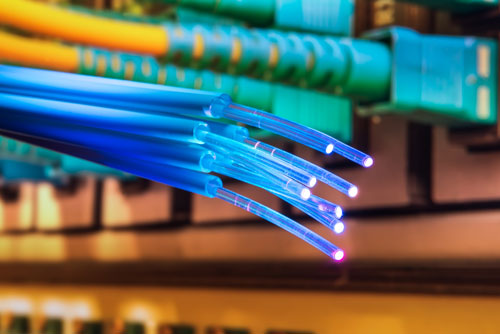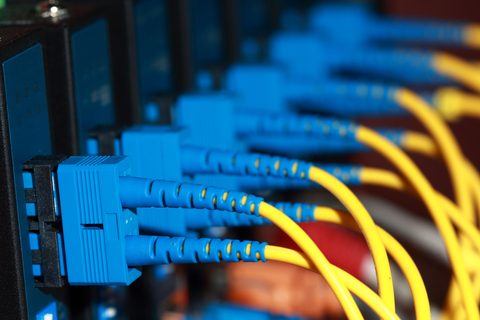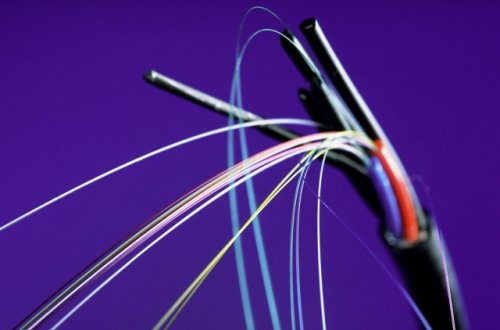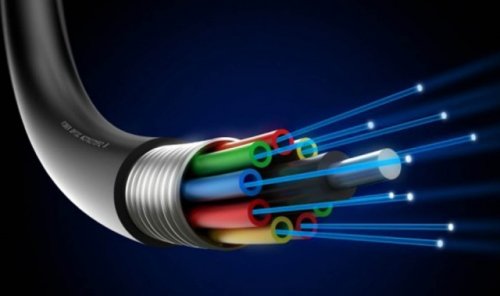Optical cables - device, types and characteristics
Optical cables, unlike cables with copper or aluminum conductors, use a transparent optical fiber as a medium to transmit a signal. The signal is transmitted here not with the help of electric current, but with the help of light. This means that practically no electrons move, but rather photons, and signal transmission losses turn out to be negligible.
These cables are ideal as a means of transmitting information, as light can pass through transparent fiberglass practically unhindered for tens of kilometers, while the intensity of the light decreases slightly.
There is GOF-Cables (Glass Optical Fiber Cable) — with glass fibers, and POF cables (plastic optical cable) — with transparent plastic fiber. Both are traditionally called optical or fiber optic cables.
Optical cable device
Fiber optic cable has a fairly simple device.In the center of the cable there is a light guide made of fiberglass (its diameter does not exceed 10 microns), dressed in a protective plastic or glass shell, which provides total internal reflection of light due to the difference in refractive indices at the boundary of two media.
It turns out that the light, all the way from the transmitter to the receiver, cannot leave the central vein. In addition, light is not afraid of electromagnetic interference, therefore such a cable does not need electromagnetic shielding, but only needs to be reinforced.
In order to ensure the mechanical strength of the optical cable, special measures are taken — they make the cable armored, especially when it comes to multi-core optical cables carrying several separate optical fibers at the same time. Suspended cables require special reinforcement with metal and Kevlar.
The simplest design of fiber optic cables is glass fibers in a plastic shell… A more complex design is a multi-layer cable with reinforcing elements, for example, for underwater, underground or suspended installation.
In a multi-layer armored cable, the supporting reinforcing cable is made of metal enclosed in a polyethylene sheath. Light-carrying plastic or glass fibers are placed around it. Each individual fiber is coated with a layer of colored varnish for color coding and protection against mechanical damage. The fiber bundles are packaged in plastic tubes filled with a hydrophobic gel.
A plastic tube can contain from 4 to 12 such fibers, while the total number of fibers in one such cable can be up to 288 pieces. The pipes are entwined with a thread that tightens the film moistened with a hydrophobic gel — for greater cushioning of mechanical influences. The pipes and central cable are enclosed in polyethylene.Next are Kevlar strands, which practically provide armor for the stranded cable. Then polyethylene again to protect it from moisture, and finally the outer shell.

The two main types of fiber optic cables
There are two types of fiber optic cables: multimode and single mode. Multi-mode ones are cheaper, single-mode ones are more expensive.

Single mode cable ensures that the rays passing through the fiber take practically the same path without significant mutual deviations, as a result, all rays arrive at the receiver at the same time and without distortion of the signal shape. The diameter of an optical fiber in a single-mode cable is about 1.3 μm, and it is at this wavelength that light must be transmitted through it.
For this reason, a laser source with monochromatic light of a strictly necessary wavelength is used as a transmitter. Precisely cables of this type (single-mode) are today considered the most promising for long-distance communications in the future, but for now they are expensive and short-lived.

Multimode cable less "accurate" than single-mode ones. The beams from the transmitter pass into it with dispersion, and on the side of the receiver there is some distortion of the shape of the transmitted signal. The diameter of the optical fiber in the multimode cable is 62.5 µm and the outer diameter of the sheath is 125 µm.
It uses a conventional (non-laser) LED on the transmitter side (0.85 μm wavelength), and the equipment is not as expensive as a laser light source, and current multimode cables have a longer lifetime. The length of cables of this type does not exceed 5 km. Typical signal transmission latency is on the order of 5 ns/m.
Advantages of fiber optic cables
In one way or another, the optical cable differs radically from ordinary electrical cables with its exceptional noise protection, which ensures maximum safety of both the integrity and confidentiality of the information transmitted through it.
Electromagnetic interference directed at an optical cable is unable to distort the light flow, and the photons themselves do not generate external electromagnetic radiation. Without breaking the integrity of the cable, it is impossible to intercept the information transmitted through it.
The bandwidth of a fiber-optic cable is theoretically 10 ^ 12 Hz, which cannot be compared with current cables of any complexity. You can easily transfer information at a speed of up to 10 Gbps per kilometer.
Fiber optic cable itself is not as expensive as thin coaxial cable. But the main share of the increase in the price of the finished network still falls on the transmitting and receiving equipment, whose task is to convert an electrical signal into light and vice versa.
The attenuation of a light signal when passing through an optical cable of a local network does not exceed 5 dB per 1 kilometer, that is, almost the same as that of a low-frequency electrical signal. Also, the higher the frequency—the stronger the advantage of the optical medium over traditional electrical wires—the attenuation increases marginally. And at frequencies above 0.2 GHz, optical cable is clearly out of competition. It is practically possible to increase the transmission distance up to 800 km.

Fiber optic cables are applicable in ring or star topology networks while completely eliminating the grounding and load balancing issues that are always relevant to electrical cables.
Perfect galvanic isolation, together with the above advantages, allows analysts to predict that in network communications, optical cables will soon completely replace electrical ones, especially given the growing shortage of copper on the planet.
Disadvantages of fiber optic cables
In fairness, we cannot fail to mention the disadvantages of optical data transmission systems, the main of which is the complexity of installing systems and the high requirements for the accuracy of installing connectors. Micron deviations during the assembly of the connector can lead to an increase in attenuation in it. Here you need high-precision welding or a special adhesive gel, the refractive index of which is similar to that of the installed fiberglass itself.
For this reason, the qualification of the staff does not allow for leniency, special tools and high skills are required for their use. Most often, they resort to the use of ready-made pieces of cable, at the ends of which ready-made connectors of the required type are already installed. To branch the signal from the optical fiber, specialized splitters are used for several channels (from 2 to 8), but when branching, light attenuation inevitably occurs.
Of course, fiber is a less strong and less flexible material than copper, and it is dangerous to bend the fiber to a radius of less than 10 cm for its safety.Ionizing radiation reduces the transparency of the optical fiber, increases the attenuation of the transmitted light signal.
Radiation resistant fiber optic cables are more expensive than conventional fiber optic cables. A sudden change in temperature can cause a crack to form in the fiber. Of course, optical fiber is vulnerable to mechanical stress, shock and ultrasound; to protect against these factors, special soft sound-absorbing materials are used from the cable sheaths.



